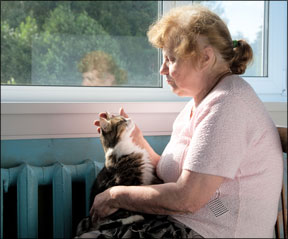When we share our lives with an animal companion, we hope that our pet will live a long, healthy and happy life. When illness strikes – especially one of a chronic nature – the devoted pet owner faces a daunting challenge. Obviously, medical care will be 288 necessary, which can be expensive and complicated. For some, however, the more difficult aspect is the emotional component. While modern-day cats are certainly receiving better veterinary care and improved nutrition, theyre also living longer. Of course, this is a blessing for cat lovers – but age also brings with it the greater likelihood of chronic disease and illness. There are some life-threatening, chronic diseases that are relatively common, according to Richard Goldstein, DVM, board-certified by the American College of Veterinary Internal Medicine and lecturer in small animal medicine at Cornell Universitys College of Veterinary Medicine. Kidney disease, or renal failure, is a serious health danger for many cats. “On average, one out of every three cats over the age of 12 develops some renal disease,” explains Dr. Goldstein. Another contender is endocrine disease – most prominently hyperthyroidism in older cats – and diabetes mellitus in cats of any age. According to Dr. Goldstein, the third most common is cancer. And there are also a variety of infections that can develop into chronic illnesses, including upper respiratory viruses like herpes, and retroviruses, most typically feline immunodeficiency virus (FIV) and feline leukemia virus (FeLV). At-Home Care Requires Dedication. Dr. Goldstein encourages clients to seek plenty of information for important decisions. “The more informed you become, the better,” says Dr. Goldstein. There are many sources of information that your veterinary team can provide. There are no dumb questions, and rarely too many questions, when speaking with the medical personnel attending your cat. Dr. Goldstein also understands that the limitations of a household – financial or otherwise – are realities in making treatment choices. A multi-cat household, for example, requires budgeting medical care for all – and spending thousands of dollars on one cats treatment may deny care that the others need. How much people are able to participate in treatment at home varies with their own comfort and ability. With diabetes, for instance, some people are prepared to administer regular insulin injections while other people are not. Cats, too, vary in their willingness to accept pilling and other treatments, like hydration. Be prepared for changes, though, even as your cat enjoys continuing health. According to Dr. Goldstein, many cats live out long and quality lives with chronic illness, while others take turns for the worse with little warning. The Owner Knows Best. Most of all, know your cat and keep alert for any changes in behavior or functioning. Many changes can be quite subtle: Recognizing them before a check-up can be invaluable. Many chronic diseases show through weight loss. If that weight loss is quite gradual, you may well not notice it until it reaches a serious level, says Dr. Goldstein. More dependable is careful weighing, hopefully on the same reliable scale. (Geriatric exams twice a year can provide this simple diagnostic check.) One family – wanting to get more frequent measures during the several-year remission of their elderly cat with lymphoma – took the cat in her carrier to their local post office lobby after-hours. There, they were able to weight her on the same sensitive scale each month, subtracting the carriers weight, and kept a careful record of her weight gains and losses that proved useful for prompt treatment decisions. Obviously, chronic illnesses can at times prove trying, and many will ultimately lead to cats deaths. Often, they can also provide a greater closeness and affection, as chronically ill cats are helped achieve a high quality of life by their devoted humans.



